7 The Central Processing Unit(CPU)
7 中央处理器
Hi, I'm Carrie Anne, this is Crash Course Computer Science
嗨,我是CarrieAnne,欢迎收看计算机科学速成课!
and today, we're talking about processors.
今天我们讲处理器
Just a warning though this is probably the most complicated episode in the series.
提示下这集可能是最难的一集
So once you get this, you're golden.
所以一旦你理解了,就会变得超厉害der~
We've already made a Arithmetic and Logic Unit,
我们已经做了一个算术逻辑单元(ALU)
which takes in binary numbers and performs calculations,
输入二进制,它会执行计算
and we've made two types of computer memory:
我们还做了两种内存:
Registers -small, linear chunks of memory, useful for storing a single value
寄存器很小的一块内存,能存一个值
and then we scaled up, and made some RAM,
之后我们增大做出了RAM
a larger bank of memory that can store a lot of numbers located at different addresses.
RAM是一大块内存,能在不同地址存大量数字
Now it's time to put it all together and build ourselves the heart of any computer,
现在是时候把这些放在一起,组建计算机的"心脏"了
but without any of the emotional baggage that comes with human hearts.
但这个"心脏"不会有任何包袱,比如人类情感.
For computers, this is the Central Processing Unit, most commonly called the CPU.
计算机的心脏是"中央处理单元",简称"CPU"
A CPU's job is to execute programs.
CPU负责执行程序
Programs, like Microsoft Office, Safari, or your beloved copy of Half Life: 2,
比如Office,Safari浏览器,你最爱的《半条命2》
are made up of a series of individual operations,
程序由一个个操作组成
called instructions, because they "instruct" the computer what to do.
这些操作叫"指令"(Instruction),因为它们"指示"计算机要做什么
If these are mathematical instructions, like add or subtract,
如果是数学指令,比如加/减
the CPU will configure its ALU to do the mathematical operation.
CPU会让ALU进行数学运算
Or it might be a memory instruction,
也可能是内存指令,
in which case the CPU will talk with memory to read and write values.
CPU会和内存通信,然后读/写值
There are a lot of parts in a CPU,
CPU里有很多组件.
so we're going to lay it out piece by piece, building up as we go.
所以我们一边说一边建
We'll focus on functional blocks, rather than showing every single wire.
我们把重点放在功能,而不是一根根线具体怎么连
When we do connect two components with a line,
当我们用一条线连接两个组件时
this is an abstraction for all of the necessary wires.
这条线只是所有必须线路的一个抽象
This high level view is called the microarchitecture.
这种高层次视角叫"微体系架构"
OK, first, we're going to need some memory.
好,我们首先要一些内存,
Lets drop in the RAM module we created last episode.
把上集做的RAM拿来就行
To keep things simple, we'll assume it only has 16 memory locations, each containing 8 bits.
为了保持简单,假设它只有16个位置,每个位置存8位
Let's also give our processor four, 8-bit memory registers, labeled A, B, C and D
再来四个8位寄存器,叫A,B,C,D
which will be used to temporarily store and manipulate values.
寄存器用来临时存数据和操作数据
We already know that data can be stored in memory as binary values
我们已经知道数据是以二进制值存在内存里
and programs can be stored in memory too.
程序也可以存在内存里
We can assign an ID to each instruction supported by our CPU.
我们可以给CPU支持的所有指令,分配一个ID
In our hypothetical example, we use the first four bits to store the "operation code",
在这个假设的例子,我们用前四位存"操作代码"(operationcode)
or opcode for short.
简称"操作码"(opcode)
The final four bits specify where the data for that operation should come from -
后四位代表数据来自哪里
this could be registers or an address in memory.
可以是寄存器或内存地址
We also need two more registers to complete our CPU.
我们还需要两个寄存器,来完成CPU.
First, we need a register to keep track of where we are in a program.
1一个寄存器追踪程序运行到哪里了,
For this, we use an instruction address register,
我们叫它"指令地址寄存器"
which as the name suggests, stores the memory address of the current instruction.
顾名思义,存当前指令的内存地址
And then we need the other register to store the current instruction,
2另一个寄存器存当前指令,
which we'll call the instruction register.
叫"指令寄存器"
When we first boot up our computer, all of our registers start at 0.
当启动计算机时,所有寄存器从0开始
As an example, we've initialized our RAM with a simple computer program that we'll to through today.
为了举例,我们在RAM里放了一个程序,我们今天会过一遍
The first phase of a CPU's operation is called the fetch phase.
CPU的第一个阶段叫"取指令阶段"
This is where we retrieve our first instruction.
负责拿到指令
First, we wire our Instruction Address Register to our RAM module.
首先,将"指令地址寄存器"连到RAM
The register's value is 0, so the RAM returns whatever value is stored in address 0.
寄存器的值为0,因此RAM返回地址0的值
In this case, 0010 1110.
101110
Then this value is copied into our instruction register.
会复制到"指令寄存器"里
Now that we've fetched an instruction from memory,
现在指令拿到了
we need to figure out what that instruction is
要弄清是什么指令,
so we can execute it.
才能执行(execute)
That is run it.
只是运行它
Not kill it.
而不是杀死(kill)它
This is called the decode phase.
这是"解码阶段"
In this case the opcode, which is the first four bits, is: 0010.
前4位0010
This opcode corresponds to the "LOAD A" instruction,
是LOADA指令
which loads a value from RAM into Register A.
意思是,把RAM的值放入寄存器A
The RAM address is the last four bits of our instruction which are 1110, or 14 in decimal.
后4位1110是RAM的地址,转成十进制是14
Next, instructions are decoded and interpreted by a Control Unit.
接下来,指令由"控制单元"进行解码
Like everything else we've built, it too is made out of logic gates.
就像之前的所有东西,"控制单元"也是逻辑门组成的
For example, to recognize a LOAD A instruction,
比如,为了识别"LOADA"指令
we need a circuit that checks if the opcode matches 0010
需要一个电路,检查操作码是不是0010
which we can do with a handful of logic gates.
我们可以用很少的逻辑门来实现.
Now that we know what instruction we're dealing with,
现在知道了是什么指令
we can go ahead and perform that instruction which is the beginning of the execute phase!
就可以开始执行了,开始"执行阶段"
Using the output of our LOAD_A checking circuit,
用"检查是否LOADA指令的电路"
we can turn on the RAM's read enable line and send in address 14.
可以打开RAM的"允许读取线",把地址14传过去
The RAM retrieves the value at that address, which is 00000011, or 3 in decimal.
RAM拿到值,00000011,十进制的3
Now, because this is a LOAD_A instruction,
因为是LOAD_A指令,
we want that value to only be saved into Register A and not any of the other registers.
我们想把这个值只放到寄存器A,其他寄存器不受影响
So if we connect the RAM's data wires to our four data registers,
所以需要一根线,把RAM连到4个寄存器
we can use our LOAD_A check circuit to enable the write enable only for Register A.
用"检查是否LOAD_A指令的电路",启用寄存器A的"允许写入线"
And there you have it
这就成功了
we've successfully loaded the value at RAM address 14 into Register A.
把RAM地址14的值,放到了寄存器A.
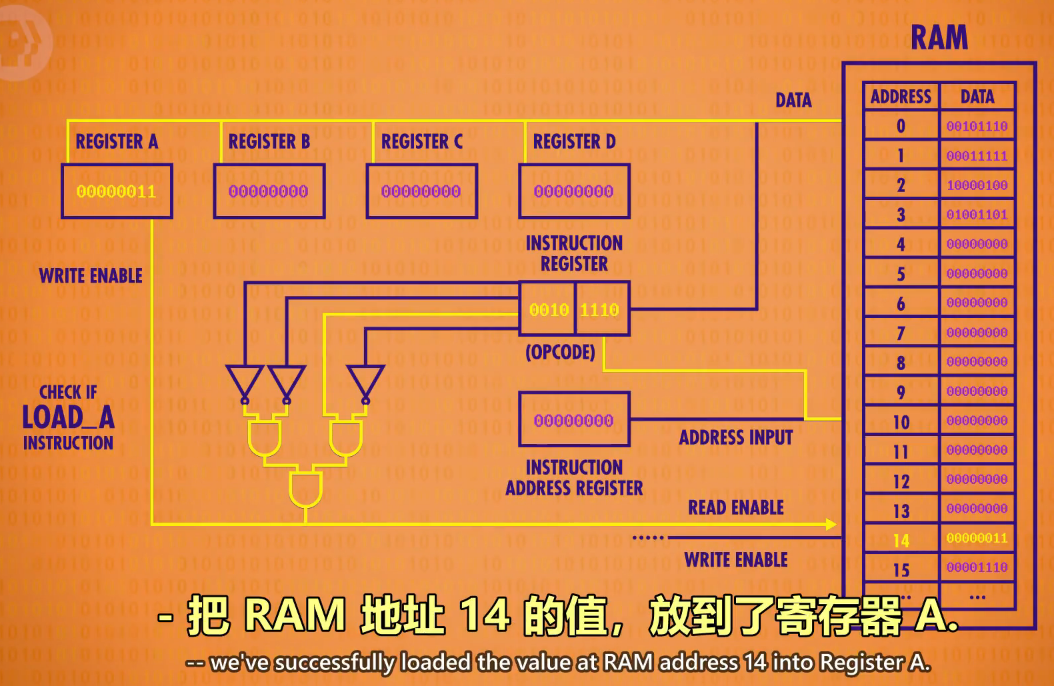
We've completed the instruction, so we can turn all of our wires off,
既然指令完成了,我们可以关掉所有线路
and we are ready to fetch the next instruction in memory.
去拿下一条指令
To do this, we increment the Instruction Address Register by 1 which completes the execute phase.
我们把"指令地址寄存器"+1,"执行阶段"就此结束.
LOAD_A is just one of several possible instructions that our CPU can execute.
LOAD_A只是CPU可以执行的各种指令之一
Different instructions are decoded by different logic circuits,
不同指令由不同逻辑电路解码
which configure the CPU's components to perform that action.
这些逻辑电路会配置CPU内的组件来执行对应操作
Looking at all those individual decode circuits is too much detail,
具体分析这些解码电路太繁琐了
so since we looked at one example,
既然已经看了1个例子,
we're going to go head and package them all up as a single Control Unit to keep things simple.
干脆把"控制单元"包成一个整体,简洁一些.
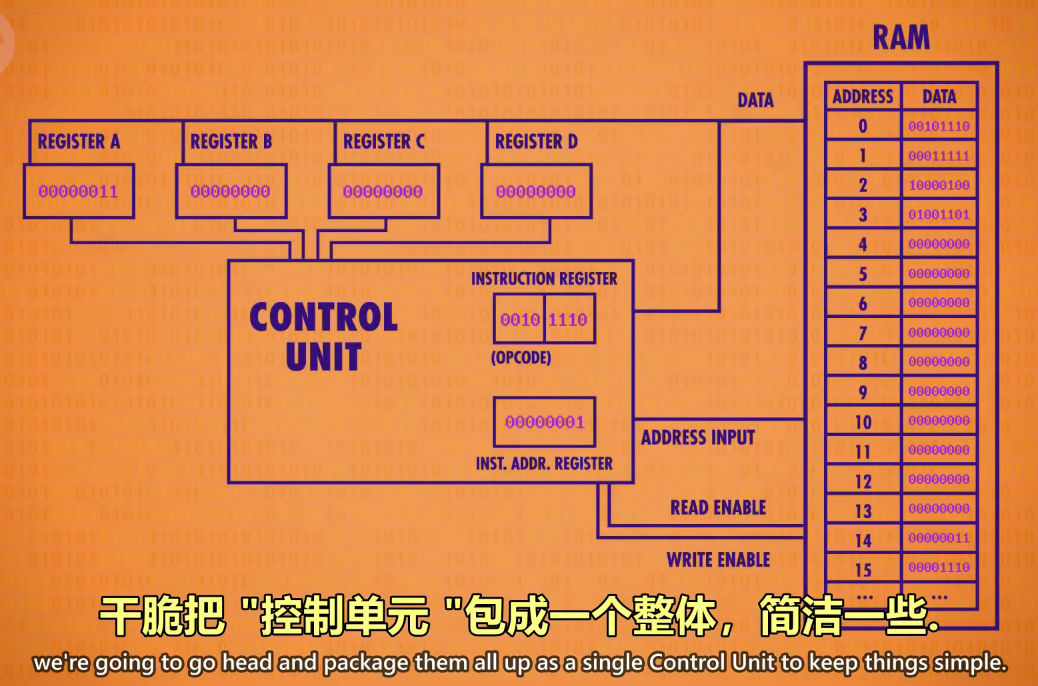
That's right a new level of abstraction.
没错,一层新抽象
The Control Unit is comparable to the conductor of an orchestra,
控制单元就像管弦乐队的指挥
directing all of the different parts of the CPU.
指挥CPU的所有组件
Having completed one full fetch/decode/execute cycle,
取指令→解码→执行完成后
we're ready to start all over again, beginning with the fetch phase.
现在可以再来一次,从"取指令"开始
The Instruction Address Register now has the value 1 in it,
指令地址寄存器现在的值是1
so the RAM gives us the value stored at address 1, which is 0001 1111.
所以RAM返回地址1里的值:00011111
On to the decode phase!
到"解码"阶段!
0001 is the "LOAD B" instruction, which moves a value from RAM into Register B.
0001是LOADB指令,从RAM里把一个值复制到寄存器B
The memory location this time is 1111, which is 15 in decimal.
这次内存地址是1111,十进制的15
Now to the execute phase!
现在到"执行阶段"!
The Control Unit configures the RAM to read address 15 and configures Register B to receive the data.
控制单元叫RAM读地址15,并配置寄存器B接收数据
Bingo, we just saved the value 00001110, or the number 14 in decimal, into Register B.
成功,我们把值00001110,也就是十进制的14存到了寄存器B
Last thing to do is increment our instruction address register by 1,
最后一件事是"指令地址寄存器"+1
and we're done with another cycle.
我们又完成了一个循环
Our next instruction is a bit different.
下一条指令有点不同
Let's fetch it.
来取它吧
1000 0100.
10000100
That opcode 1000 is an ADD instruction.
1000是ADD指令
Instead of an 4-bit RAM address, this instruction uses two sets of 2 bits.
这次后面的4位不是RAM地址,而是2位2位分别代表2个寄存器
Remember that 2 bits can encode 4 values,
2位可以表示4个值
so 2 bits is enough to select any one of our 4 registers.
所以足够表示4个寄存器
The first set of 2 bits is 01, which in this case corresponds to Register B,
第一个地址是01,代表寄存器B
and 00, which is Register A.
第二个地址是00,代表寄存器A
So "1000 01 00" is the instruction for adding the value in Register B into the value in register A.
因此,10000100,代表把寄存器B的值,加到寄存器A里
So to execute this instruction, we need to integrate the ALU we made in Episode 5 into our CPU.
为了执行这个指令,我们要整合第5集的ALU
The Control Unit is responsible for selecting the right registers to pass in as inputs,
控制单元负责选择正确的寄存器作为输入
and configuring the ALU to perform the right operation.
并配置ALU执行正确的操作
For this ADD instruction, the Control Unit enables Register B
对于"ADD"指令,"控制单元"会
and feeds its value into the first input of the ALU.
启用寄存器B,作为ALU的第一个输入
It also enables Register A and feeds it into the second ALU input.
还启用寄存器A,作为ALU的第二个输入
As we already discussed, the ALU itself can perform several different operations,
之前说过,ALU可以执行不同操作
so the Control Unit must configure it to perform an ADD operation by passing in the ADD opcode.
所以控制单元必须传递ADD操作码告诉它要做什么
Finally, the output should be saved into Register A.
最后,结果应该存到寄存器A
But it can't be written directly
但不能直接写入寄存器A
because the new value would ripple back into the ALU and then keep adding to itself.
这样新值会进入ALU,不断和自己相加
So the Control Unit uses an internal register to temporarily save the output,
因此,控制单元用一个自己的寄存器暂时保存结果
turn off the ALU, and then write the value into the proper destination register.
关闭ALU,然后把值写入正确的寄存器
In this case, our inputs were 3 and 14, and so the sum is 17, or 00010001 in binary,
这里3+14=17,二进制是00010001
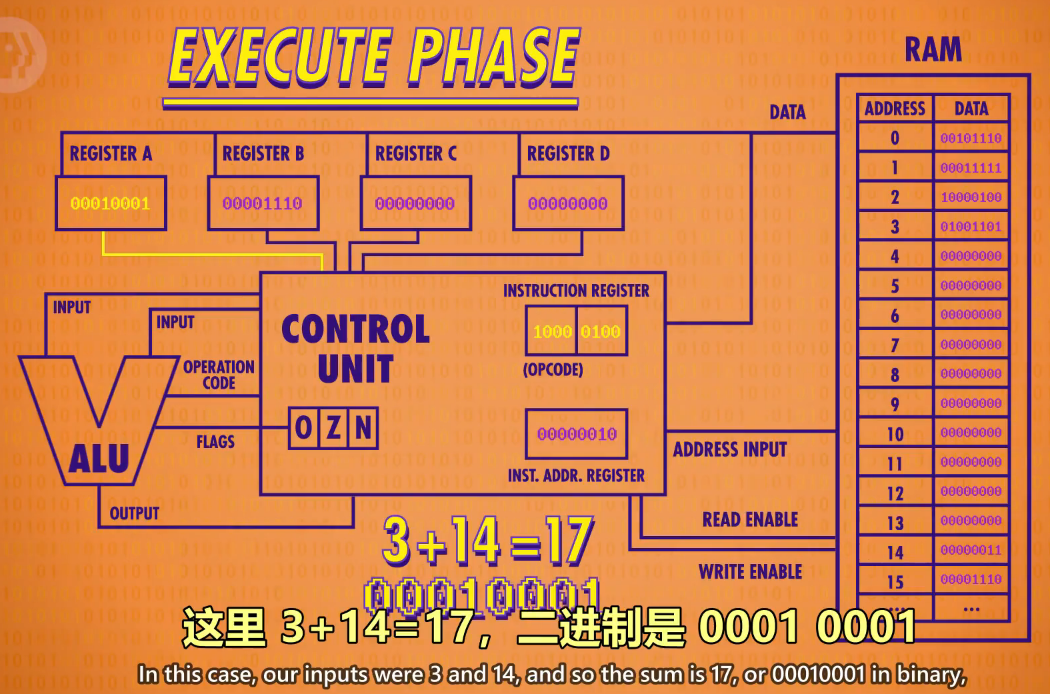
which is now sitting in Register A.
现在存到了寄存器A
As before, the last thing to do is increment our instruction address by 1,
和之前一样,最后一件事是把指令地址+1
and another cycle is complete.
这个循环就完成了
Okay, so let's fetch one last instruction: 0100 1101.
好,来看最后一个指令:01001101
When we decode it we see that 0100 is a STORE_A instruction, with a RAM address of 13.
解码得知是STOREA指令(把寄存器A的值放入内存),RAM地址13
As usual, we pass the address to the RAM module,
接下来,把地址传给RAM
but instead of read-enabling the memory, we write-enable it.
但这次不是"允许读取",而是"允许写入"
At the same time, we read-enable Register A.
同时,打开寄存器A的"允许读取"
This allows us to use the data line to pass in the value stored in register A.
这样就可以把寄存器A里的值,传给RAM
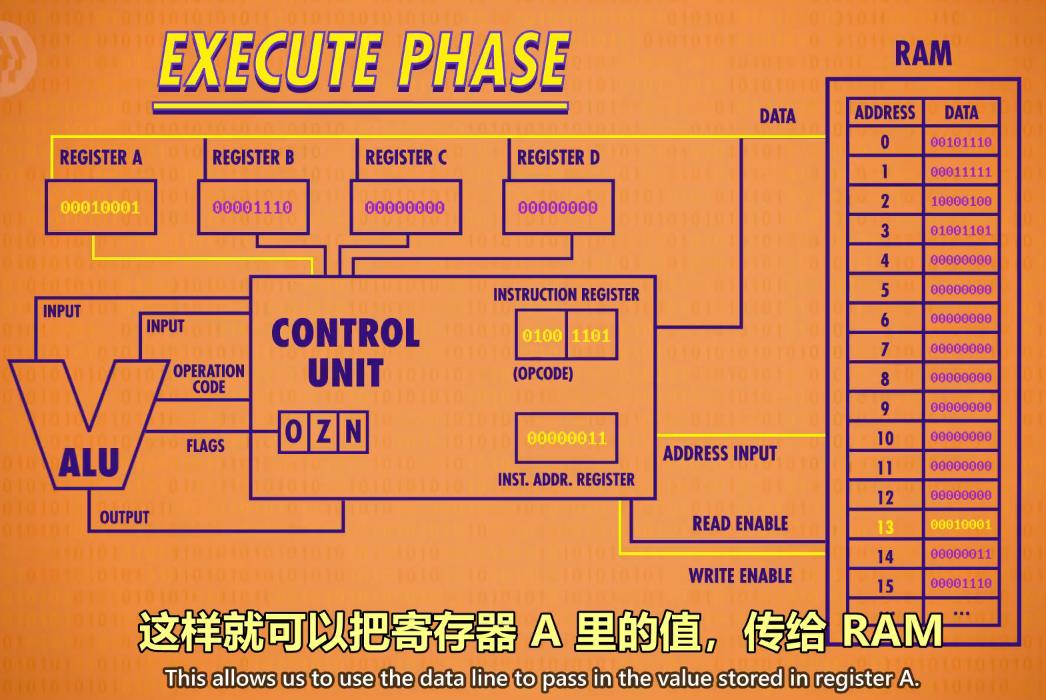
Congrats, we just ran our first computer program!
恭喜,我们刚运行了第一个电脑程序!
It loaded two values from memory, added them together,
它从内存中加载两个值,相加,然后把结果放回内存
and then saved that sum back into memory.
它从内存中加载两个值,相加,然后把结果放回内存
Of course, by me talking you through the individual steps,
刚刚是我一步步来讲的,
I was manually transitioning the CPU through its fetch, decode and execute phases.
我们人工切换CPU的状态"取指令→解码→执行"
But there isn't a mini Carrie Anne inside of every computer.
但不是每台电脑里都有一个迷你CarrieAnne
So the responsibility of keeping the CPU ticking along falls to a component called the clock.
其实是"时钟"来负责管理CPU的节奏
As it's name suggests, the clock triggers an electrical signal at a precise and regular interval.
时钟以精确的间隔触发电信号
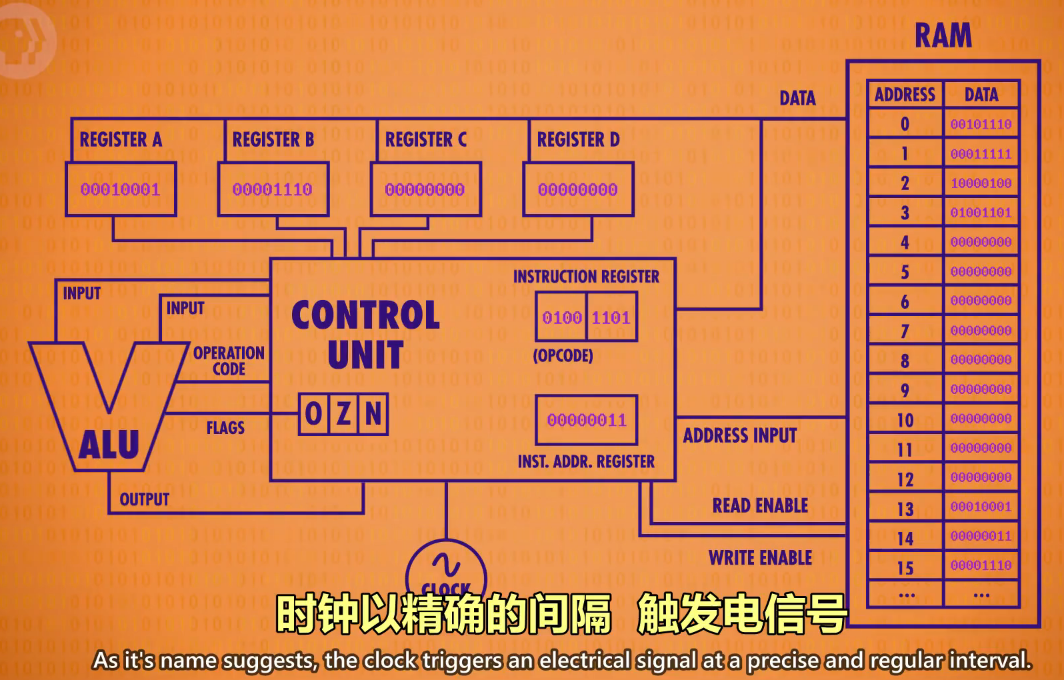
Its signal is used by the Control Unit to advance the internal operation of the CPU,
控制单元会用这个信号,推进CPU的内部操作
keeping everything in lock-step
确保一切按步骤进行
like the dude on a Roman galley drumming rhythmically at the front,
就像罗马帆船的船头,有一个人负责按节奏的击鼓,
keeping all the rowers synchronized... or a metronome.
让所有划船的人同步...就像节拍器一样
Of course you can't go too fast,
节奏不能太快
because even electricity takes some time to travel down wires and for the signal to settle.
因为就算是电也要一定时间来传输
The speed at which a CPU can carry out each step of the fetch-decode-execute cycle
CPU"取指令→解码→执行"的速度
is called its Clock Speed.
叫"时钟速度"
This speed is measured in Hertz a unit of frequency.
单位是赫兹赫兹是用来表示频率的单位
One Hertz means one cycle per second.
1赫兹代表一秒1个周期
Given that it took me about 6 minutes to talk you through 4 instructions
因为我花了大概6分钟,给你讲了4条指令
LOAD, LOAD, ADD and STORE
读取→读取→相加→存储
that means I have an effective clock speed of roughly .03 Hertz.
所以我的时钟速度大概是0.03赫兹
Admittedly, I'm not a great computer
我承认我算数不快
but even someone handy with math might only be able to do one calculation in their head every second or 1 Hertz.
但哪怕有人算数很快,最多也就是一秒一次,或1赫兹
The very first, single-chip CPU was the Intel 4004, a 4-bit CPU released in 1971.
第一个单芯片CPU是"英特尔4004",1971年发布的4位CPU
It's microarchitecture is actually pretty similar to our example CPU.
它的微架构很像我们之前说的CPU
Despite being the first processor of its kind,
虽然是第一个单芯片的处理器
it had a mind-blowing clock speed of 740 Kilohertz
但它的时钟速度达到了740千赫兹
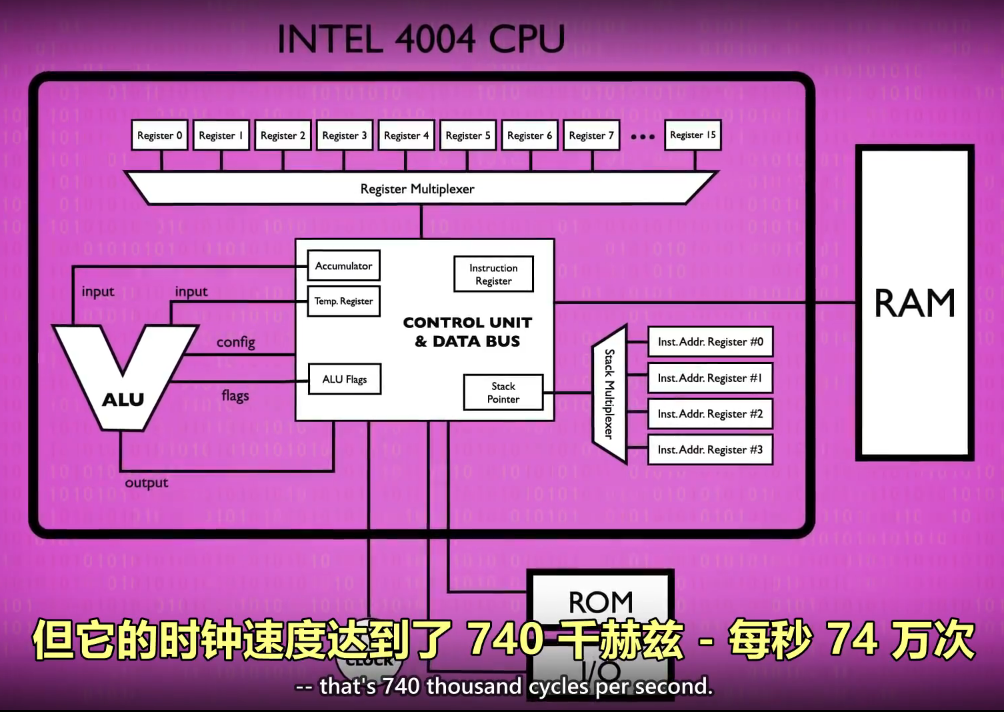
that's 740 thousand cycles per second.
每秒74万次
You might think that's fast,
你可能觉得很快
but it's nothing compared to the processors that we use today.
但和如今的处理器相比不值一提
One megahertz is one million clock cycles per second,
一兆赫兹是1秒1百万个时钟周期
and the computer or even phone that you are watching this video on right now is no doubt a few gigahertz
你现在看视频的电脑或手机,肯定有几千兆赫兹
that's BILLIONs of CPU cycles every single... second.
1秒10亿次时钟周期
Also, you may have heard of people overclocking their computers.
你可能听过有人会把计算机超频
This is when you modify the clock to speed up the tempo of the CPU
意思是修改时钟速度,加快CPU的速度
like when the drummer speeds up when the Roman Galley needs to ram another ship.
就像罗马帆船要撞另一艘船时,鼓手会加快敲鼓速度
Chip makers often design CPUs with enough tolerance to handle a little bit of overclocking,
芯片制造商经常给CPU留一点余地,可以接受一点超频
but too much can either overheat the CPU,
但超频太多会让CPU过热
or produce gobbledygook as the signals fall behind the clock.
或产生乱码,因为信号跟不上时钟
And although you don't hear very much about underclocking,
你可能很少听说降频
it's actually super useful.
但降频其实很有用
Sometimes it's not necessary to run the processor at full speed...
有时没必要让处理器全速运行
maybe the user has stepped away, or just not running a particularly demanding program.
可能用户走开了,或者在跑一个性能要求较低的程序
By slowing the CPU down, you can save a lot of power,
把CPU的速度降下来,可以省很多电
which is important for computers that run on batteries, like laptops and smartphones.
省电对用电池的设备很重要,比如笔记本和手机
To meet these needs,
为了尽可能省电
many modern processors can increase or decrease their clock speed based on demand,
很多现代处理器可以按需求加快或减慢时钟速度
which is called dynamic frequency scaling.
这叫"动态调整频率"
So, with the addition of a clock, our CPU is complete.
加上时钟后,CPU才是完整的.
We can now put a box around it, and make it its own component.
现在可以放到盒子里,变成一个独立组件
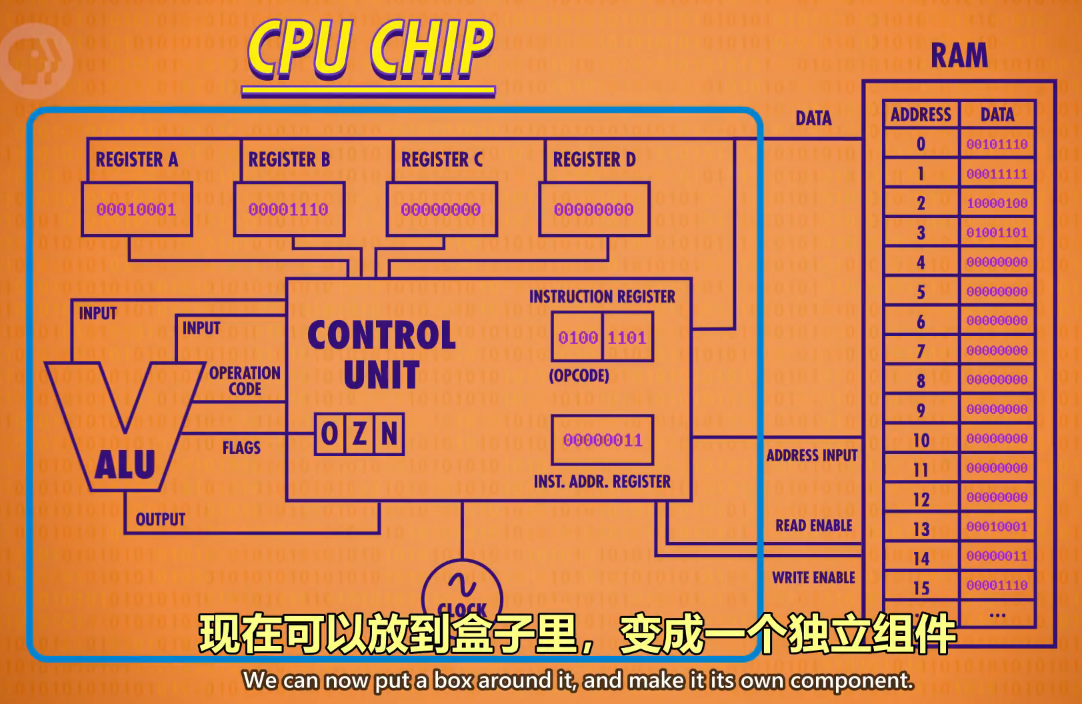
Yup.
对
A new level of abstraction!
一层新的抽象!
RAM, as I showed you last episode,
RAM,上集说过,
lies outside the CPU as its own component,
是在CPU外面的独立组件
and they communicate with each other using address, data and enable wires.
CPU和RAM之间,用"地址线""数据线"和"允许读/写线"进行通信
Although the CPU we designed today is a simplified example,
虽然今天我们设计的CPU是简化版的,
many of the basic mechanics we discussed are still found in modern processors.
但我们提到的很多机制,依然存在于现代处理器里
Next episode, we're going to beef up our CPU,
下一集,我们要加强CPU,给它扩展更多指令.
extending it with more instructions as we take our first baby steps into software.
同时开始讲软件.
I'll see you next week.
下周见